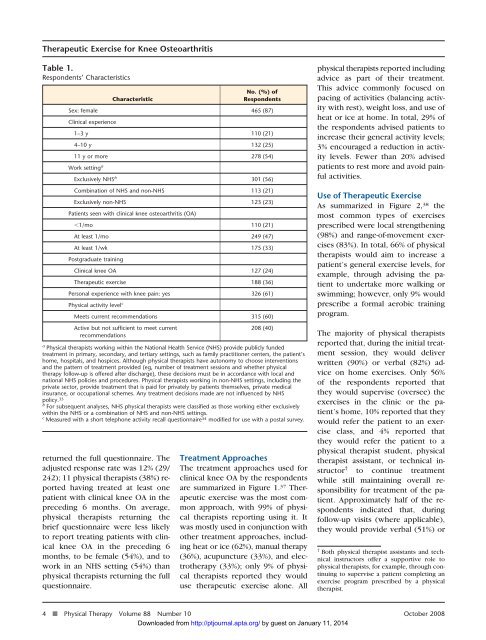Physical Therapists' Use of Therapeutic Exercise for Patients With ...
Physical Therapists' Use of Therapeutic Exercise for Patients With ...
Physical Therapists' Use of Therapeutic Exercise for Patients With ...
Create successful ePaper yourself
Turn your PDF publications into a flip-book with our unique Google optimized e-Paper software.
<strong>Therapeutic</strong> <strong>Exercise</strong> <strong>for</strong> Knee Osteoarthritis<br />
Table 1.<br />
Respondents’ Characteristics<br />
Characteristic<br />
returned the full questionnaire. The<br />
adjusted response rate was 12% (29/<br />
242); 11 physical therapists (38%) reported<br />
having treated at least one<br />
patient with clinical knee OA in the<br />
preceding 6 months. On average,<br />
physical therapists returning the<br />
brief questionnaire were less likely<br />
to report treating patients with clinical<br />
knee OA in the preceding 6<br />
months, to be female (54%), and to<br />
work in an NHS setting (54%) than<br />
physical therapists returning the full<br />
questionnaire.<br />
No. (%) <strong>of</strong><br />
Respondents<br />
Sex: female 465 (87)<br />
Clinical experience<br />
1–3 y 110 (21)<br />
4–10 y 132 (25)<br />
11 y or more 278 (54)<br />
Work setting a<br />
Exclusively NHS b 301 (56)<br />
Combination <strong>of</strong> NHS and non-NHS 113 (21)<br />
Exclusively non-NHS 123 (23)<br />
<strong>Patients</strong> seen with clinical knee osteoarthritis (OA)<br />
1/mo 110 (21)<br />
At least 1/mo 249 (47)<br />
At least 1/wk 175 (33)<br />
Postgraduate training<br />
Clinical knee OA 127 (24)<br />
<strong>Therapeutic</strong> exercise 188 (36)<br />
Personal experience with knee pain: yes 326 (61)<br />
<strong>Physical</strong> activity level c<br />
Meets current recommendations 315 (60)<br />
Active but not sufficient to meet current<br />
208 (40)<br />
recommendations<br />
a <strong>Physical</strong> therapists working within the National Health Service (NHS) provide publicly funded<br />
treatment in primary, secondary, and tertiary settings, such as family practitioner centers, the patient’s<br />
home, hospitals, and hospices. Although physical therapists have autonomy to choose interventions<br />
and the pattern <strong>of</strong> treatment provided (eg, number <strong>of</strong> treatment sessions and whether physical<br />
therapy follow-up is <strong>of</strong>fered after discharge), these decisions must be in accordance with local and<br />
national NHS policies and procedures. <strong>Physical</strong> therapists working in non-NHS settings, including the<br />
private sector, provide treatment that is paid <strong>for</strong> privately by patients themselves, private medical<br />
insurance, or occupational schemes. Any treatment decisions made are not influenced by NHS<br />
policy. 35<br />
b For subsequent analyses, NHS physical therapists were classified as those working either exclusively<br />
within the NHS or a combination <strong>of</strong> NHS and non-NHS settings.<br />
c Measured with a short telephone activity recall questionnaire 34 modified <strong>for</strong> use with a postal survey.<br />
Treatment Approaches<br />
The treatment approaches used <strong>for</strong><br />
clinical knee OA by the respondents<br />
are summarized in Figure 1. 37 <strong>Therapeutic</strong><br />
exercise was the most common<br />
approach, with 99% <strong>of</strong> physical<br />
therapists reporting using it. It<br />
was mostly used in conjunction with<br />
other treatment approaches, including<br />
heat or ice (62%), manual therapy<br />
(36%), acupuncture (33%), and electrotherapy<br />
(33%); only 9% <strong>of</strong> physical<br />
therapists reported they would<br />
use therapeutic exercise alone. All<br />
physical therapists reported including<br />
advice as part <strong>of</strong> their treatment.<br />
This advice commonly focused on<br />
pacing <strong>of</strong> activities (balancing activity<br />
with rest), weight loss, and use <strong>of</strong><br />
heat or ice at home. In total, 29% <strong>of</strong><br />
the respondents advised patients to<br />
increase their general activity levels;<br />
3% encouraged a reduction in activity<br />
levels. Fewer than 20% advised<br />
patients to rest more and avoid painful<br />
activities.<br />
<strong>Use</strong> <strong>of</strong> <strong>Therapeutic</strong> <strong>Exercise</strong><br />
As summarized in Figure 2, 38 the<br />
most common types <strong>of</strong> exercises<br />
prescribed were local strengthening<br />
(98%) and range-<strong>of</strong>-movement exercises<br />
(83%). In total, 66% <strong>of</strong> physical<br />
therapists would aim to increase a<br />
patient’s general exercise levels, <strong>for</strong><br />
example, through advising the patient<br />
to undertake more walking or<br />
swimming; however, only 9% would<br />
prescribe a <strong>for</strong>mal aerobic training<br />
program.<br />
The majority <strong>of</strong> physical therapists<br />
reported that, during the initial treatment<br />
session, they would deliver<br />
written (90%) or verbal (82%) advice<br />
on home exercises. Only 56%<br />
<strong>of</strong> the respondents reported that<br />
they would supervise (oversee) the<br />
exercises in the clinic or the patient’s<br />
home, 10% reported that they<br />
would refer the patient to an exercise<br />
class, and 4% reported that<br />
they would refer the patient to a<br />
physical therapist student, physical<br />
therapist assistant, or technical instructor<br />
† to continue treatment<br />
while still maintaining overall responsibility<br />
<strong>for</strong> treatment <strong>of</strong> the patient.<br />
Approximately half <strong>of</strong> the respondents<br />
indicated that, during<br />
follow-up visits (where applicable),<br />
they would provide verbal (51%) or<br />
† Both physical therapist assistants and technical<br />
instructors <strong>of</strong>fer a supportive role to<br />
physical therapists, <strong>for</strong> example, through continuing<br />
to supervise a patient completing an<br />
exercise program prescribed by a physical<br />
therapist.<br />
4 f <strong>Physical</strong> Therapy Volume 88 Number 10 October 2008<br />
Downloaded from http://ptjournal.apta.org/ by guest on January 11, 2014
















